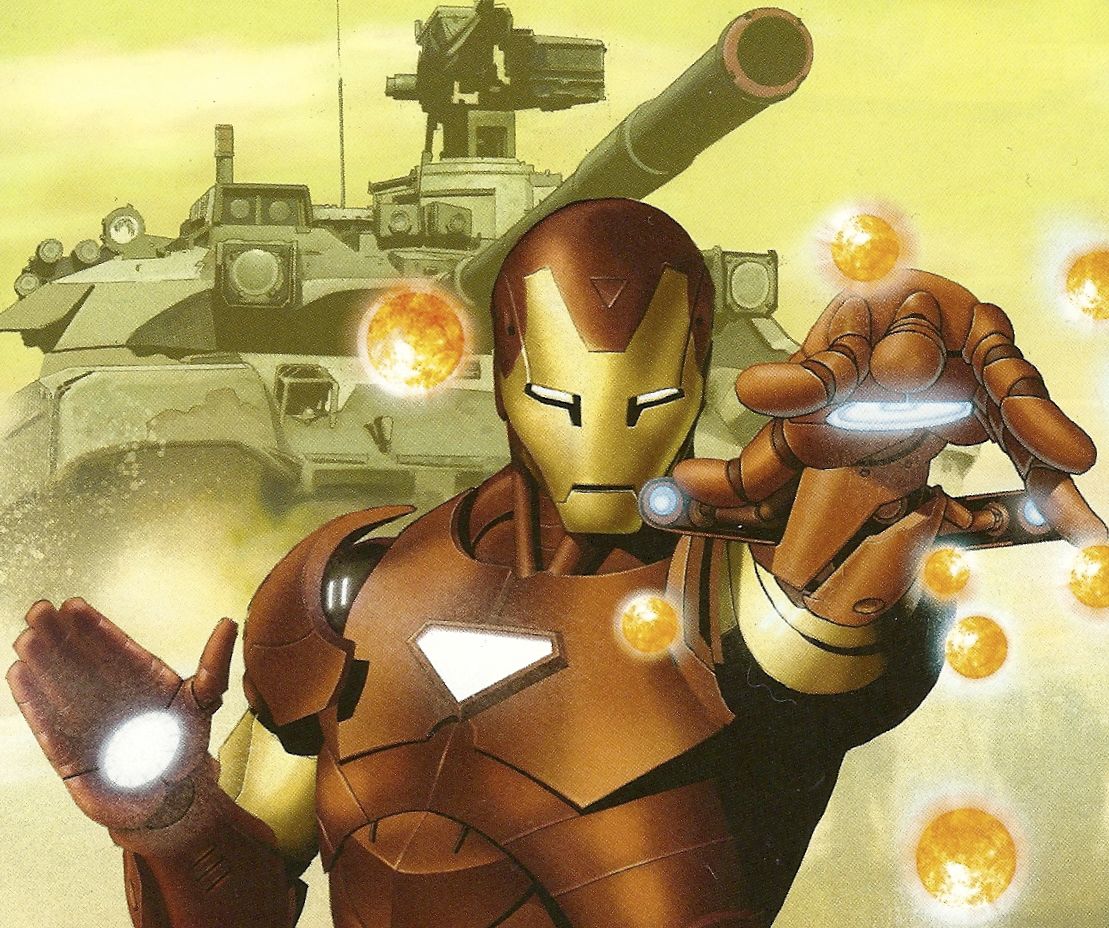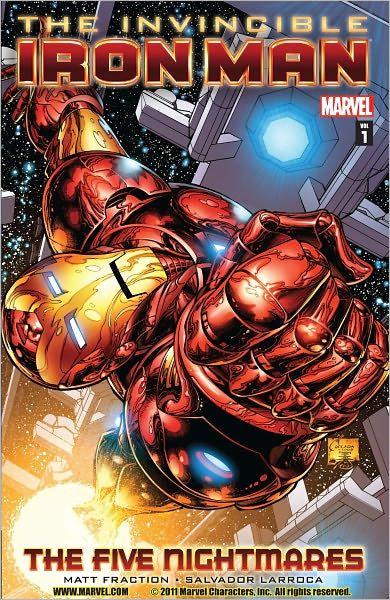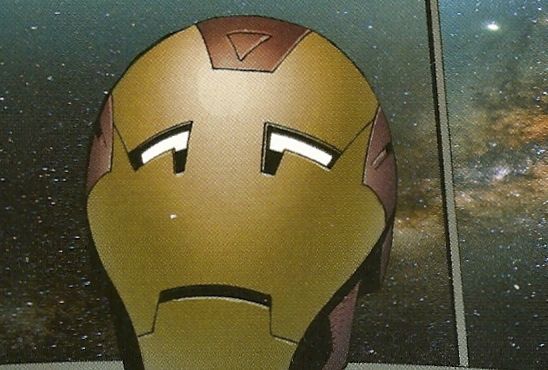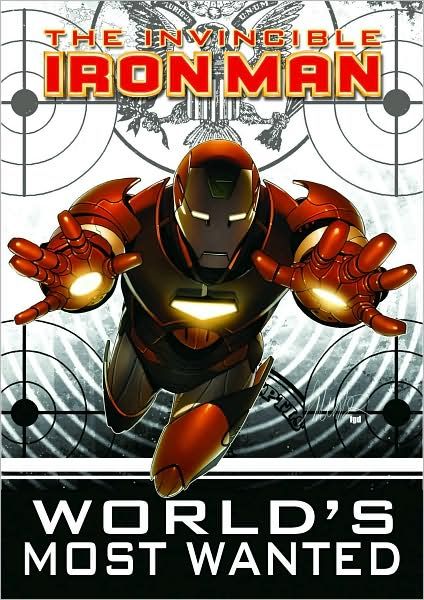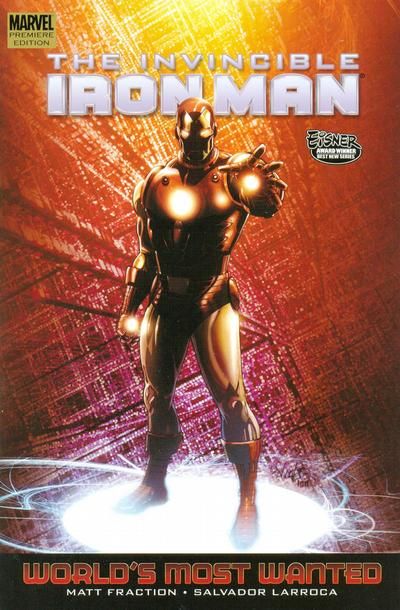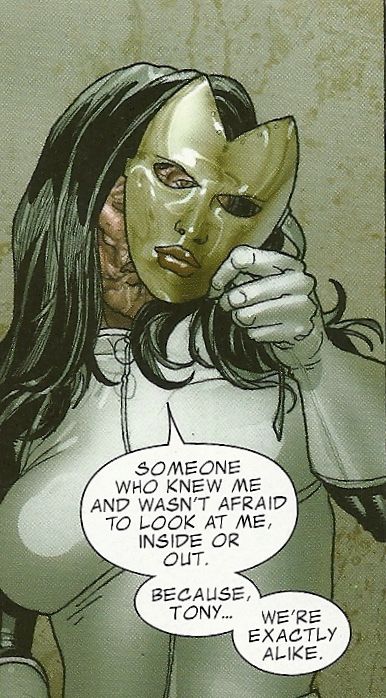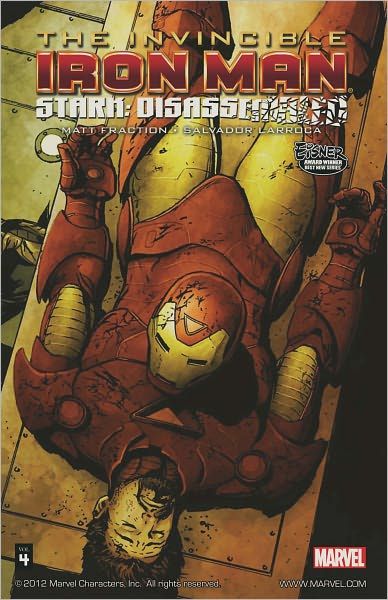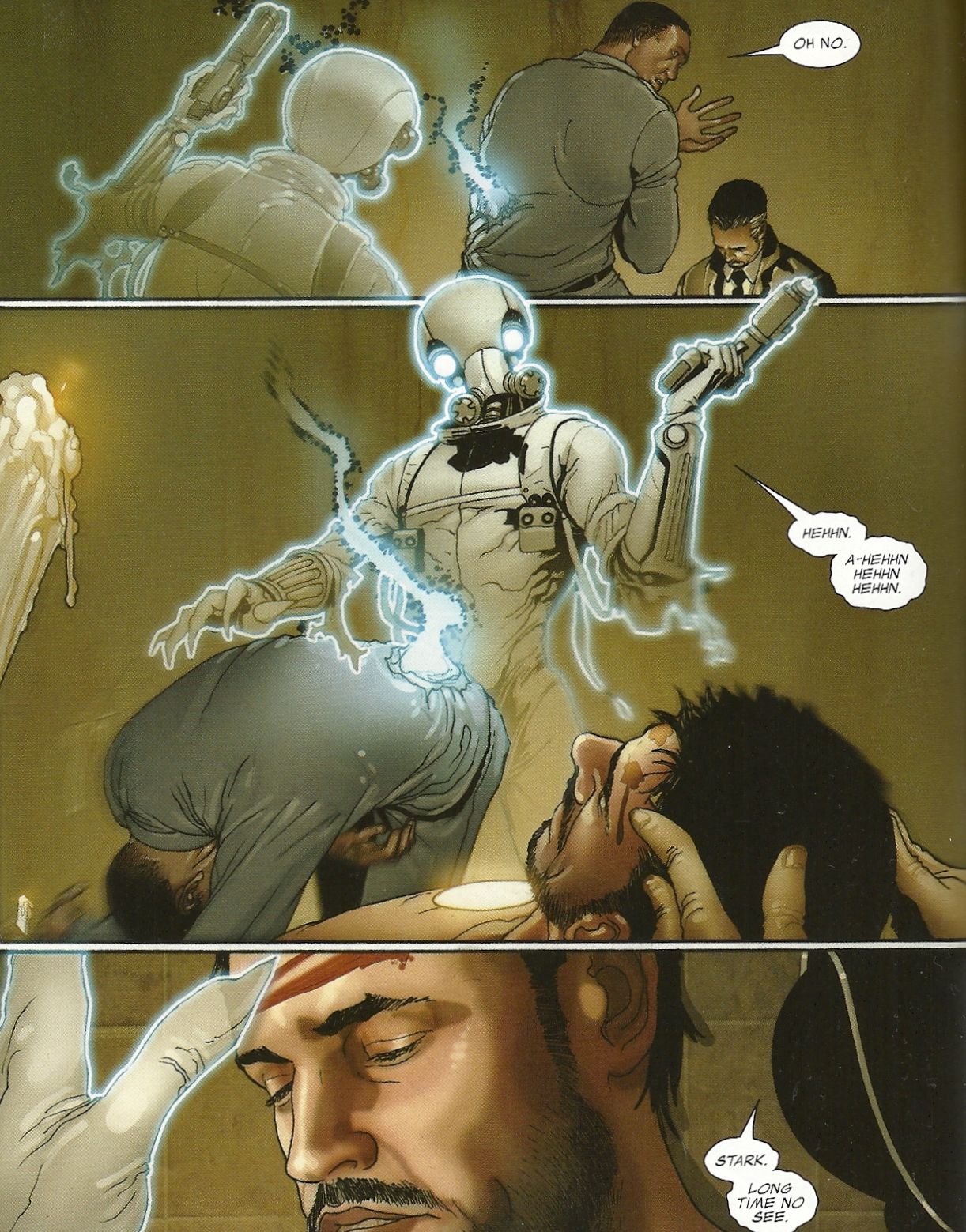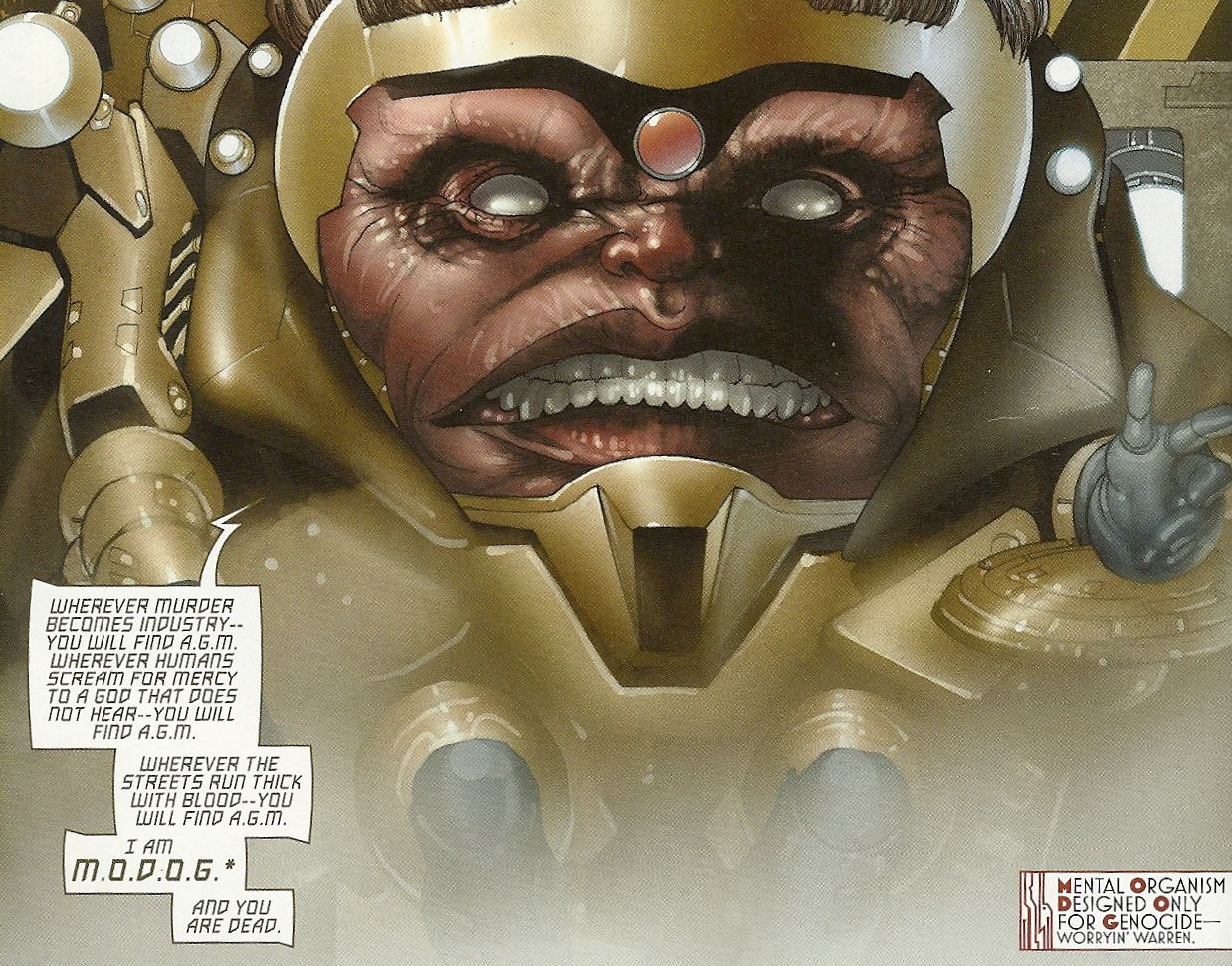Oh, good, you came back. Today we're going to take a look at the first four collections worth of Matt Fraction, Salvador Larroca and company's The Invincible Iron Man, which accounts for the first 24 issues of the series and two of the several completely different (but narratively and thematically connected) directions the series took.
The Invincible Iron Man, Vol. 1: The Five Nightmares (#1-7): As I mentioned Tuesday, this title launched the same summer that director Jon Favreau's Iron Man, starring Robert Downey Jr. as Tony Stark, opened, and writing a new, second title with Iron Man as the hero must have seemed a rather daunting task, given that Downey and Favreau's cool, charming war profiteer turned warrior for peace bore little resemblance to the Marvel Universe version of the character of the time, whom writer Mark Millar had turned into the publisher's greatest villain during Civil War and its aftermath.
The attempt to embrace a potential Hollywood-driven new audience wasn't obvious just in the choice of Larroca as artist, although his photo-realistic artwork and Frank D'Armata's (often-overbearing) coloring certainly would've given something familiar to a reader who had previously only seen Iron Man in a live-action movie.
No, Fraction seemingly took several cues from the movie, including dialing down the villainous aspects of Stark and upping his charm (this would get increasingly Downey-like as the series progressed). He also gave major roles to Pepper Potts, who became more of a co-star, as well as the other half of a will-they, won't-they romantic plot, and to James "Rhodey" Rhodes, who similarly had a large role as Stark's best friend and confidant.
The villain of this first arc was notably Ezekiel Stane, the son of Iron Man (the movie) villain Obadiah Stane, who set about attempting to dismantle and destroy Iron Man, Tony Stark and Stark Industries, succeeding where his father failed — not only in the comics but in the movie as well (so, in a way, "The Five Nightmares" read not only as a continuation of plotlines from the comic, but also as a sort of unofficial sequel to the 2008 film).
In the first issue of the series, Tony Stark is the cool executive with a heart of steel who runs his company, plays superhero and serves as director of S.H.I.E.L.D. (i.e. the Boss of All Superheroes), the role he won in Civil War. The arc gets its names from the five nightmares he rattles off while narrating the premiere issue, the first of which involves his alcoholism (while there might not have been room to deal with Stark's alcoholism in a movie without surrendering the entire movie to that conflict, Fraction's got hundreds and hundreds of pages, and thus has no problem incorporating that aspect of the character ), the remainder of which deal with Iron Man technology becoming cheap, disposable, easily accessible and put in the hands of people he can't trust — or, in other words, war-fighting becoming not simply the province of wealthy and sane nation states, but small, independent, off-the-grid cells of crazy people.
Stane brings four of those five nightmares to life throughout the arc, and if Iron Man is a superhero symbol of the American military industrial complex as a force for good, then Stane is a super-symbol for terrorism. So Stane is the younger, hungrier, more ruthless version of Stark, and using black-market Iron Man tech he invents his own new generation man-machine fusion weapon, and he and his girlfriend Sasha go to war with Stark and Potts.
This is the first major conflict of the series, and it's focused on the evolution of technology and warfare, an ongoing concern of the book, something that's always humming along in the background of the character sub-plots and in the front-and-center, action-driving conflicts.
At the risk of spoiling the arc, Stark wins, but the six-issue story all but destroys the status quo, so that now Stark as a corporate entity is no more and Potts is transformed — she survives the destruction of a building she's in, but only by having a repulsor-powered disc similar to Stark's surgically implanted in her chest (in a neat bit of symbolism that would be tediously precious in almost any other genre, the pair now literally have matching hearts, unlike those of anyone else in the world).
The collection closes out with a one-issue epilogue guest-starring Spider-Man. Read now, it's a nice team-up story that demonstrates how much the two characters have in common and how much divides them; your basic compare and contrast team-up comic. And we're so far removed from the One More Day reboot of Spider-Man that the continuity shenanigans are easy to ignore (in fact, if you don't know the history of the two heroes' relationship, this reads just fine). But I imagine originally it must have been frustrating as all get-out, as some of their exchanges don't really make any sense (which was to be expected; the reboot itself didn't make any sense).
While Fraction is already firing on all cylinders here, Larroca and D'Armata's art can be tough to read, and it's not as strong as it will get a few volumes down the line. The use of photo imagery is distracting and leads to some dispiritingly out-of-synch character "acting" that reminds me of the work of Greg Land. (Hey, guess what title he's currently providing art for?)
The designs don't seem to have been nailed down all that well, either. While Stark and Potts look the same throughout the first volume, Stane's face morphs form panel to panel with his changing expressions (as if different models were used for each image), and supporting character Maria Hill, who functions here as a sort of secondary, S.H.I.E.L.D. version of Potts, changes hair and skin color a few times.
The second-to-last-panel of Issue 6 also features a hilariously overdone image of the Iron Man mask over-emoting; the current mask always looked like it was wearing a frown, but in this scene, during which Stark broods about his role in the world, Larroca draws it like this:
The trade contains all of the variant covers in a gallery at the end, and I was caught off-guard to see this little gem:
I had completely forgotten about the month or so in which Marvel released “Marvel Ape” variant covers. Such surprises would be a constant in the future volumes of the series, as Marvel did more variant cover schemes, some of them as wacky as that one, throughout the years in which Fraction and Larroca were working on this run, and there’s a sort of time capsule element to these galleries now.
Vols. 2 and 3: World's Most Wanted Books 1 and 2 (#8-19): Between the last page of The Five Nightmares and the first page of World's Most Wanted Book 1, something happened — Secret Invasion.
That was, if you were lucky enough not to have read it, the Brian Michael Bendis-written, Leinil Francis Yu-drawn 2008 series about Skrulls infiltrating Earth that would take far too many paragraphs to recount here (and I'm not sure I entirely understood it anyway; the Skrulls were sort of simultaneously attempting a peaceful, propaganda-driven coup/conversion of Earth and violently invading using souped-up Super-Skrulls, I think ...?).
For the purposes of Iron Man, all that's really important is that Stark loses his job as director of S.H.I.E.L.D. (and the agency itself is abolished) because he was blamed for not being able to protect Earth from the Skrull invasion. In his place, President Barack Obama makes former Green Goblin (and convicted murderer!) Norman Osborn the new Boss of All Superheroes, and his new S.H.I.E.L.D.-like agency is the meaner-sounding H.A.M.M.E.R. (this would have been during the "Dark Reign" status quo of the Marvel Universe).
Because Stark suspects that putting an insane supervillain in charge of all of the superheroes and America's military will likely lead to abuse of some kind, Stark uploads a virus that wipes out all of the records he was in possession of (the secret identities of all registered superheroes, for example) and then sets about deleting the last remaining copy of all of that information too dangerous to fall into Osborn's hand — Stark's own brain.
To do this, he must travel the world, stopping in at secret bases and deleting a piece of his brain here and there; after each mind-wiping, he has to revert to an older, less-sophisticated version of his Iron Man suit, so Fraction and Larroca treat us to a sort of backward tour of Iron Man history during what's essentially a 12-part chase story.
During this arc, Potts gets her own suit of Iron Man armor with an A.I. feature named J.A.R.V.I.S. that talks to her (like Tony's suit in the movies). Her suit isn't a weapon, but utilizes the same fantastic technology for defensive and rescue purposes. She gives herself the superhero identity Rescue (were I Gwyneth Paltrow, this might be my favorite storyline, as it's the one where Potts becomes a superhero in her own right).
While Osborn is obviously the main villain of this arc, Stark, Potts, Hill and the Black Widow -- hey, I wonder if it's a coincidence the superheroine appearing in Iron Man 2 is in the book at this point? -- run afoul of various lieutenant villains, the biggest traditional Iron Man rogue encountered being Madame Masque (probably the best candidate for a villain in Iron Man 4, if they ever make an Iron Man 4).
Just as Fraction has written the book that one need not have read Secret Invasion to be able read and enjoy this story of Stark and the villain Osborn essentially trading roles, one need not read Siege (another Bendis-written event series) to understand why Osborn loses his position of power; Fraction's plotting gives a parallel sequence of events in which Osborn's greed, madness, overreach and general villainy lead to a very public downfall. It's a sequence that works just fine as its own or as a companion to Osborn's actions in Siege, a series that made absolutely no sense at all to me.
The bad news is that while Stark technically wins the main conflict, evading capture until he's able to almost completely erase his own brain, it's a pyrrhic victory, given that he ends up in a vegetative state.
Larroca's art is pretty great by this point in the series, and the use of photo-imagery has become much more restrained. Characters occasionally morph between designs — Osborn sometimes looks to be 30, sometimes 60, and his hair color changes from dark to gray — but it's head and shoulders above what it was in Five Nightmares.
Volume 3 contains a few pages of pencils from Issue 19, which shows how good Larroca's line work looks without any color muddying it up. I'm not sure if the intention was to excuse him for the poor quality of the art, but it read to me as a defense: "Look, it's not the artist, it's the colorist!"
Volume 4: Stark Disassembled (#20-24): So Civil War, "The Initiative," Secret Invasion, "Dark Reign" and Siege are all finally in the rear-view mirror, and Iron Man is finally free from being a pawn in the Marvel Universe mega-story (at least for a while), allowing Fraction to forge a new direction for the character that has little to nothing to do with what's being decided by Marvel editors and "Architects" at editorial retreats.
In many ways, this story arc may be the most clever, demonstrating the smartest-guy-in-the-room/ futurist take on Tony Stark to the Nth degree and using the (relatively) unique man/machine core of the Iron Man hero to essentially excuse him for a lot of the out-of-character actions he'd taken during his Civil War-to-Dark Reign period as Marvel's main villain.
When the story opens, he's essentially in a terminal coma, having erased all of the data in his brain. But he has a back-up for his own mind, and a way to come back from the dead, as he's planned for this very contingency. In a holographic message to Pepper Potts, he lays out his plan, which will involve the coordinated efforts of Potts, Hill, Captain America, Thor and Doctor Strange. Essentially, he leaves it up to them (especially Potts) to decide if they want him back or not.
Obviously they do, and Tony Stark eventually comes back to life, but with no memory of his actions prior to the last time he "saved" his mind on the back-up, which just so happens to be before Civil War. Viewed cynically then, Marvel so screwed up the character that Fraction had to reboot Stark to salvage him, although it's well worth noting that unlike the Spider-Man reboot mentioned earlier, this one works perfectly well within the milieu of the character.
Fraction even takes it a step further, by tying Stark's acceptance of his actions and the negative repercussions of them to his alcoholism: He has more than a little experience with waking up to find he's made terrible mistakes and hurt people he cares about, having no memory of actually doing those things, but having to take responsibility for them anyway.
As Stark is in a coma for the majority of this arc, most of his panel time occurs within the dreams of his barely alive brain, where Doctor Strange visits him and tries to talk him into coming back to life (the mechanical bits of restarting Stark like a computer involve Thor's lightning and Cap's shield and, yes, a bit of hand-waving).
Within Stark's dreams is a vision a particular future invention of his ... one that will eventually pay off in about eight more trades. Fraction is doing some serious long-term planning with this book, despite the zigzagging changes in direction.
This arc also features a classic Iron Man villain who would also make a good candidate for an Iron Man 4, The Ghost. It's kind of subtle at first, but Fraction and Larroca are working there way through Iron Man's rogues gallery, with many of the foes serving as henchmen or employees of the bigger villains. By the time the run's over, however, just about all of them will make an appearance in one form or another (as for MODOK, a MODOG — Mental Organism Designed Only for Genocide — had a small, several-page role in the Five Nightmares).
Tomorrow: Stark Resilient and My Monsters.

